Ancient and Medieval States
Background
Early Islamic States
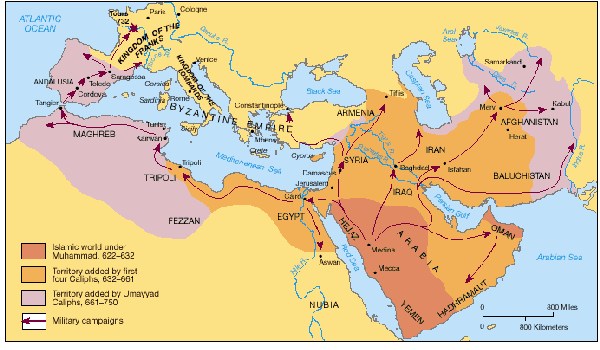
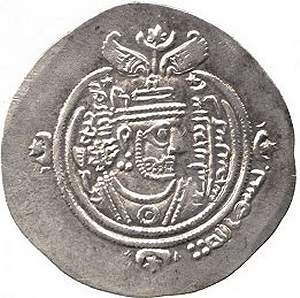 | The Arab ConquestThe Arabs first attacked Sasanian territory in 633, when general Khalid ibn Walid invaded Mesopotamia, but lost ground when the general was transferred to the Byzantine front. A second attack came in 636 when Saad ibn Abi Waqqas won the Battle of Qadisiyyah and took west Iran from Sasanian control. Caliph Umar ordered a full invasion of the Sasanian empire in 642, and this was completed around 651. |
Arab Sasanian Ar Drachm. 'Ubayd Allah b. Ziyad, Silver Drachm. Minted at Tisfun in 63 AH (Walker p.72; Baloch 19; Album 12) | These well coordinated, multi-pronged attacks were directed from Medina, several thousand miles from the battlefields, a triumph for the Caliph, though many cities later rose in revolt. Arab reinforcements succeeded in putting down the rebellions in time, and imposing the rule of Islam, but often at great cost. |
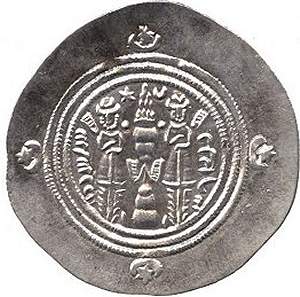 | Conversion to Islam in Persia was generally slow and violent, with Zoroastrian scriptures burnt and priests executed. For generations many Persians maintained their original language and culture, as the Arab-Sasanian coinage indicates. Some recent historians have questioned the official narrative (which derives from western sources), suggesting the Sasanian Empire was decentralized, and indeed more of a 'confederation' with independent Parthian forces. {5-10} |
Reverse: Zoroastrian fire altar with attendants: year of issue on left and mint at right. {1} {4} | The first decades of Muslim rule in Iran saw Sasanian coins minted as before, showing the continuity of administration and economic life in the early years of Muslim rule. |
But when Yazdegerd died in AD 651, the words Besm Allah in Arabic were added. The mints included Basra, Susa, Bishapur, Darabgerd, Estakr, Arrajan, Gur, Yazd, Zaranj, Marw, Nishapur, Hamadan, Ray, Nehavand, Isfahan, several in Kerman province, and a few as yet unidentified. Diameter and weight varied considerable (from 2 to over 4 grams) but silver fineness was better than 90% and generally around 95%. In the year 79 AH (698-99 AD) a new standard was introduced at Damascus and at nearly thirty mints throughout the east. The new dirhems bore nothing but date, mint and religious inscriptions, all in Arabic, but the Sasanian-style dirhems continued a little longer at a few mints, notably in Fars, where they were issued along with the new dirhems. The last date for a regular Arab-Sasanian drahm is 85 AH (AD 704-5) {1, 10-14}
The Sasanian Empire
Though the Sasanian shahs tried to bring the country under direct rule, often by turning villages into towns with skilled working communities administered by governors collecting tax revenues, the land-owning nobles seem to have retained some autonomy, enough to occasionally overthrow the ruler. Agriculture, widely diversified, was the basis of the economy, though there was also mining, quarrying, forestry, an army, a priesthood and skilled trades organised as corporations in the cities or attached to the royal workshops. Quite how society — royalty, nobility, 'free citizens', prisoners of war, and slaves — was organised is not clear, nor the status of the many Christian communities, who may have been private entrepreneurs. But transcontinental trade was an important ingredient, and there were numerous fairs and markets. {14-15}
Sasanian power had been weakened by the military adventures of Khosrau II against the Byzantines, and by disastrous wars with the Hephthalites, or white Huns. But the causes of Sasanian defeat have been modified by recent historians to include internal struggles with the Parthians, who remained fighting forces within a decentralised Persian confederacy, and the part played by small, semi-independent Arab principalities forming a buffer zone to the Byzantine territories. Kosrau II was assassinated in February 628, and the Arab conquest may indeed have been earlier than once supposed, perhaps 628 to 632. {5}
New Arab State
As we know from papyrus records in Egypt, the first Arab administrations simply replaced the local governors with Arab ones. The Sasanian treasury was sacked, and other plunder no doubt carried off, but the Arab-Sasanian dirhems were probably struck for tax payments, i.e. the country continued along its earlier lines, though with frequent uprisings and Zoroastrian repression. It was clearly better to have some authority shown on these early Arab coins, even an obsolete authority, than no authority at all.
The Arabs brought new concepts to their conquered lands. Literacy was encouraged, as was knowledge of the Qur'an. Agriculture was still the mainstay of economic life, but land was distributed in a more egalitarian way. Anyone, whatever race or gender, could buy plots of land for farming or house construction. Indeed one of the Prophet's companions protested against the excessive concentration of wealth under ‘Uthmān's caliphate and argued for its redistribution. Taxes (e.g. Zakat and Jizya) were collected to provide income the needy: the poor, elderly, orphans, widows, and the disabled. Governments were also expected to stockpile food supplies in case disaster or famine struck. The Umayyad Caliphate, though regarded by Islamic commentators as too worldly, {16-17} thus created the first welfare state. {18}
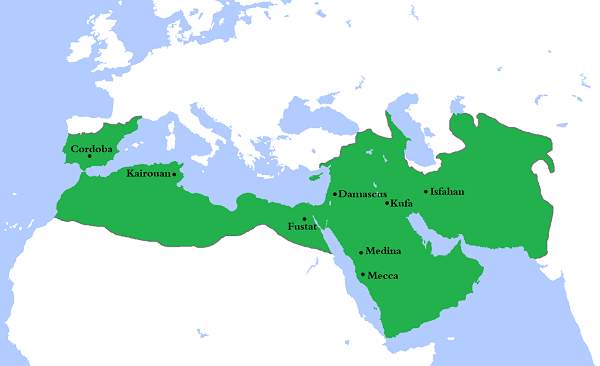
Indeed the whole nature of society slowly changed in the first four centuries of Islamic rule, which introduced concepts that were to influence medieval Europe. Islamic Persia was not feudal, but based on the concept of a just community, where trade and commercial activities were encouraged within a framework of partnership (mufawada) and early forms of capital (al-mal). It was a monetised society that also used cheques and promissory notes, trusts and loans, ledgers and assignments. Many facilities were independent of the state. The Qur'an prohibited usury, but there did in time arise banking-like groups of merchants (Karimas) who controlled trade across the Islamic world. Development into a full capitalist system was prevented by landowners (ikta), however, and by state monopolies. In short, it was neither a proto-capitalist, nor a socialist society of wealth redistribution, but one governed by custom (al-urf), reason (al-'aqi) and consensus of the jurists (al-ijim). where wealth was not despised but had nonetheless to be acquired and spent to the benefit of all. In practice, Islamic states were no more examples of shining Muslim rectitude than were Christian states models of compassion and charity, of course, and warfare was endemic in later dynasties, as much with other Muslim states as against the infidels. {18}
From Mixed to Reform Coinage: Currency War
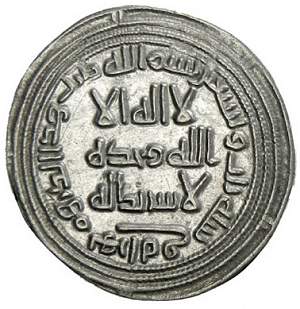 | Initially, the Umayyads employed silver Sasanian coins in Persia, and gold and copper Byzantine coins in Syria and Egypt. But, in an attempt to unify the Arab world, the Caliph Abd al-Malik ibn Marwan (685-705 CE) introduced a Umayyad gold coin in 691 or 692. This new dinar also showed three figures on the obverse, replaced the Byzantine cross on the reverse with three steps and a column topped by a sphere, and added an Arabic legend. Though similar in weight, design and purity to the Byzantine solidus, it was not acceptable to the Byzantines, and Justinian II struck a new solidus with the head of Christ on the obverse and an image of himself robed and holding a cross on the reverse. The Caliph's response to this challenge was to issue a new dinar in 693. Here the obverse showed the upright figure of the caliph, wearing an Arab headdress and holding a sword, with the testimony of Islam inscribed in the margin. The reverse bore the same column on three steps and the sphere, but a new legend appeared around the margin: 'In the name of God this dinar was struck in the year four and seventy.' |
Umayyad Ar dihem of al-Walid I Herat mint, 93 AH. (Album 128) Central legend: la ilah illa Allah wahdahu la sherik lahu (there is no God except Allah. He is alone. No partner to him. Marginal legend: bismillah zuriba haza ed-dirhem bi-Herat fi sanat thelath wa tis'in (by the grace of God was struck this dirhem at Herat in the year three and ninety) | |
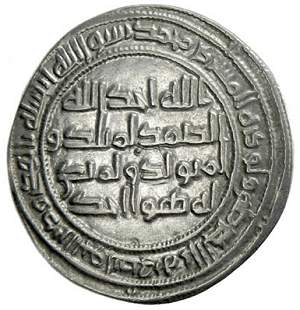 | Perhaps not many were struck as only eight now survive, but again the Byzantine emperor responded by striking a new coin in imitation of the dinar. Finally, therefore, in 697, the caliph abandoned the attempt at a parallel currency, and introduced a design that was to serve throughout the Islamic world for centuries. Figurative representation was replaced with verses (suras) from the Qur'an. Round the reverse margin ran another sura, but on the obverse margin was a standardised statement of the denomination, mint and AH year: 'By the grace of God was struck this dinar at (city name) in the year (written out in full)'. The new dirhem was similar (shown left) and modelled on the Sasanian dirhems, but smaller and lighter. These changes were thought important: all previous coinage, Arab and Byzantine, had to be brought in for immediately reminting, on pain of death. Umayyad gold coins were generally struck in Damascus, but silver and copper coins come from many towns and cities, their number increasing as Islam conquered more of north Africa and Spain.{19-20} As before, silver and gold were probably minted for tax purposes and large commercial transactions, but a diverse and complicated copper coinage was struck for local needs. To deter abrasion and clipping of the gold and silver coins, merchants in both empires employed weights and measures, generally metal in the Byzantine Empire, and glass in the Muslim.{22} Both empires lay on the western end of the international silk routes, which brought not only silks designed for Christian and Muslim luxury markets (though silk was also made locally), but spices, ceramics, and gunpowder. Exported the other way to China were carpets, jewels, metals (particularly silver), dies, drugs and glassware {24} Recent reassessments of the silk route suggest that the trade was often small and locally fragmented, however, though still serving as a conduit for ideas, religions and technologies. {14} Trade in western Asia itself concentrated on gold, ivory and slaves via the north African coast, and slaves, wood products, amber and furs from the Black Sea areas controlled by Byzantium. |
Central legend: sura 112. Allah ahad Allah es-Samad lem yalid wa lem yulad wa lem yakun lahu kufu ahad (Allah is One. Allah is the Eternal. He did not beget and he was not begotten, and there was not to Him equal a single one.) |
Though Christians and Moslems sensibly traded with each other, there were also wars by sea and land at frequent intervals btween the 7th and 11th centuries. The Umayyads repeatedly invaded Byzantine lands, but Byzantium itself survived sieges until later Ottoman times. A fortified and depopulated buffer zone was created in the Taurus Mountains after the second Arab siege of 718, however, and the Byzantines began their own destructive but unsuccessful raids after 740. Arab fleets were later to conquer Crete, Malta and Sicily, and raid as far as France and the Dalmatian coast. {23}
Just as money grows out of the values, beliefs and customs of societies, giving them commercial advantages, we see that demoninations are themselves not created in vacuo, but grow out of previous coinage traditions.
References and Further Reading
Need the 26 references and 4 illustration sources? Please consider the inexpensive ebook.
